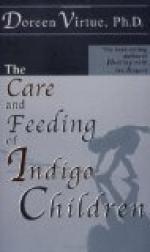What is the cry of pain?
It is usually strong and sharp, but not generally continuous. It is accompanied by contraction of the features, drawing up of the legs, and other symptoms of distress.
What is the cry of hunger?
It is usually a continuous, fretful cry, rarely strong and lusty.
What is the cry of temper?
It is loud and strong and accompanied by kicking or stiffening of the body, and is usually violent.
What is the cry of illness?
There is usually more of fretfulness and moaning than real crying, although crying is excited by very slight causes.
What is the cry of indulgence or from habit?
This is often heard even in very young infants, who cry to be rocked, to be carried about, sometimes for a light in the room, for a bottle to suck, or for the continuance of any other bad habit which has been acquired.
How can we be sure that a child is crying to be indulged?
If it stops immediately when it gets what it wants, and cries when it is withdrawn or withheld.
What should be done if a baby cries at night?
One should get up and see that the child is comfortable—the clothing smooth under the body, the hands and feet warm, and the napkin not wet or soiled. If all these matters are properly adjusted and the child simply crying to be taken up, it should not be further interfered with. If the night cry is habitual some other cause should be sought (see page 121).
How is an infant to be managed that cries from temper, habit, or to be indulged?
It should simply be allowed to “cry it out.” This often requires an hour, and in extreme cases, two or three hours. A second struggle will seldom last more than ten or fifteen minutes, and a third will rarely be necessary. Such discipline is not to be carried out unless one is sure as to the cause of the habitual crying.
Is it likely that rupture will be caused from crying?
Not in young infants if the abdominal band is properly applied, and not after a year under any circumstances.
LIFTING CHILDREN
How should a young baby be lifted from its bed?
The right hand should grasp the clothing below the feet, and the left hand should be slipped beneath the infant’s body to its head. It is then raised upon the left arm.
What is the advantage of this?
The entire spine is supported, and no undue pressure is made upon the chest or abdomen, as often happens if the baby is grasped around the body or under the arms.
How should a child old enough to run about be lifted?
Always by placing the hands under the child’s arms, and never by the wrists.
What injury may be inflicted by lifting the child by the wrists or hands?




